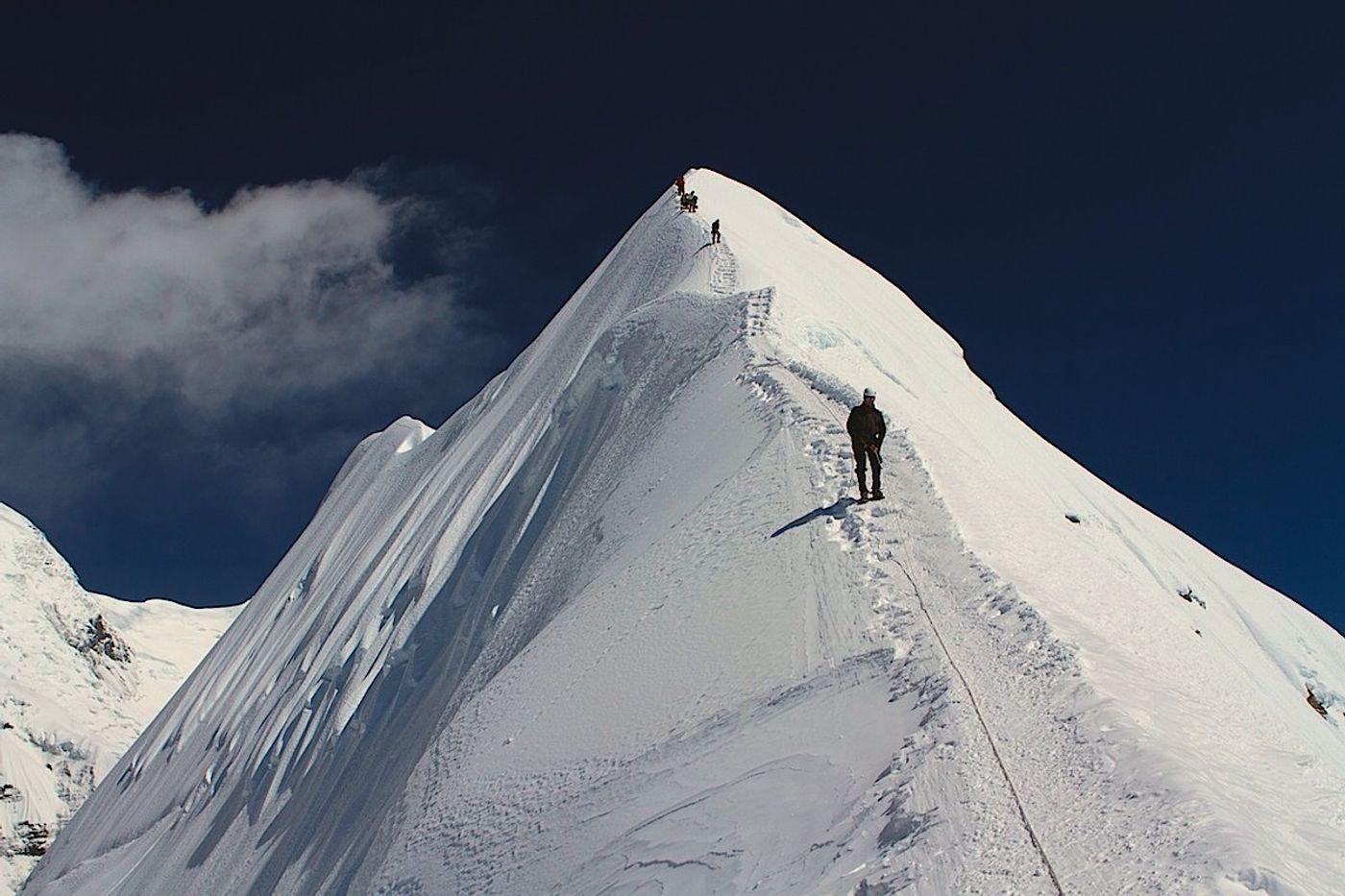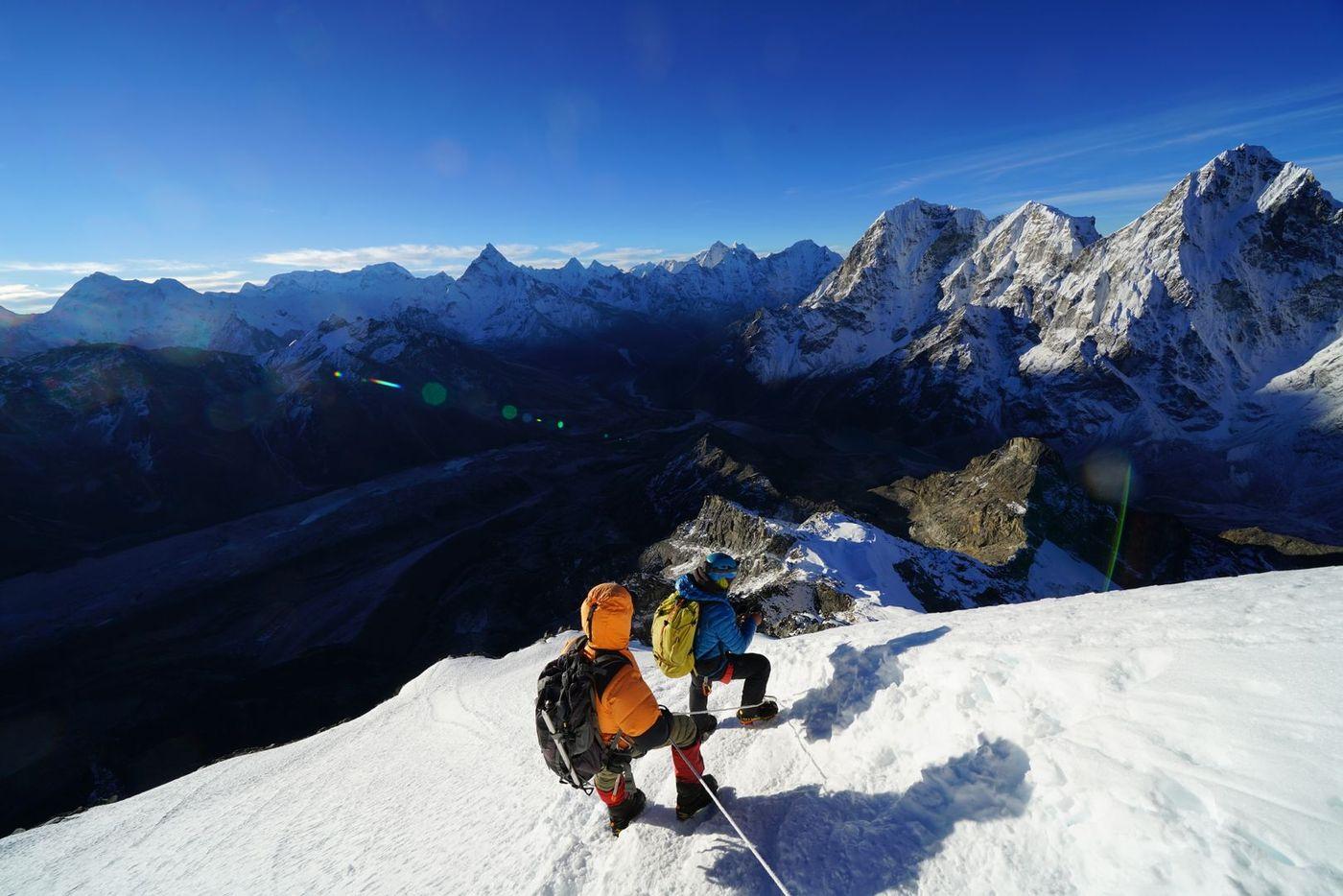Nepal has three classic 'first 6000 meter peak' mountains: Island Peak (6,189m), Lobuche East (6,119m), and Mera peak (6,476m).
All are ideal for anyone with some entry level mountaineering experience, but are of course a big step up given the altitude.
They are all in the Everest region, although Mera peak is quite a detour. Whereas Lobuche East and Island peak are simpler additions on to an Everest trek (Everest base camp, or Everest three passes). Many will add them on to a trek, since that way not only do you get to hike through one of the worlds most beautiful and best equipped trekking regions - you also acclimatise nicely for the said climb.
First of all, let's look at each mountain before comparing them.
Island Peak

This is probably the most popular, as many see it as being easier than Lobuche (the other option that's easy to add on to an Everest region trek. It's less steep than Lobuche East, although does have quite a few obstacles.
Most of the climb is a straight forward hike up to crampon point at around 5500 meters. From there you must traverse one or two crevasses. Ladders are set up to help here. You're attached to ropes at all times, but this is still a bit unnerving.
After crossing the crevasse and taking a meandering but gentle path in between them up the glacier, you'll get to a final incline. It's about 45-50 degrees, and with fixed ropes. Likely there'll be some traffic here given the mountains popularity. Given how high you've climbed, the traffic presents a welcome slow down before reaching the summit.
Read more about: Island peak.
Lobuche East

Lobuche east is much higher up towards Everest base camp and is often used by Everest climbers to acclimate. You will start from a high camp (5,450m) making the climb only (650 meters), and optionally stay in the lower base camp on the way if not already acclimated.
It's about 2-3 hours from Lobuche village to high camp. 30-40 minutes just to the base camp.
It has a reputation of being 'more technical' than Island peak, but I don't think this is true. It is a bit of a steep scramble in one or two places between high camp and crampon point - but nothing at all difficult. There are some ropes to hold on to as you find your way up.
The route up from high camp to crampon point is largely solid rock. So it is a little steep in places, but ultimately easier to move up compared to loose scree (as on Island peak).
From crampon point it's straight up. The slope is around 50 degrees, and has fixed lines all the way up. It's steep enough to be somewhat tiring, but not so steep it's scary.
You'll gain height faster too, which is a plus.
Slowly, as the sun comes up you'll approach the summit. A lovely narrow ridge which affords incredible views of surrounding peaks and valleys.
Read more about: Lobuche East.
Mera Peak

Mera Peak is the tallest of all three (6,476m), but perhaps the easiest.
It has a base camp and high camp, and from there it's just a 700 meter push to the summit.
Despite its height, it's regarded as an easier 6000 meter peak for beginners since the route up to the summit is very gentle.
From Lukla, where you'll likely fly into (but hiking in is a beautiful option - and affords better acclimatisation), it's 5-6 days east to base camp. This is in the opposite direction to Everest region. This means you avoid the hordes of crowds, but if you plan to trek EBC will prolong your trip a lot.
Read more about: Mera Peak.
Comparison
Difficulty
Mera peak is technically the easiest, followed by Lobuche east and Island peak in joint second place. Lobuche is steeper but more straight forward. Island peak is not steep, but has more obstacles to get past. Given Mera's extra height, more endurance is needed. Those few hundred metres will feel like a lot more above 6000 meters.
Note: Some readers have commented out that Island peak has gotten a little harder the last year or two, with slightly less snow. So perhaps now it's the most difficult of the three.
Summit push gain
How high will you ascend on summit night
Island peak: 1,100 meters (or if you use high camp - 900 meters, but few use this option)
Lobuche east: 600 meters
Mera peak: 700 meters
Practicality
Lobuche east and Island peak are easy to slot on to any Everest region trek (but arrange your tour or permits before leaving Kathmandu). Mera Peak is a lot quicker to access from these other two, although that's only a plus if you are just climbing one of the peaks and not planing on trekking EBC/etc too.
Views
All give spectacular views. Although I'd say Lobuche east has the best. Not only can you see the biggest peaks in the world (and one of the most beautiful - Ama Dablam), you also have a great view down the main valleys of the Everest region. Island peak has a great view of Ama Dablam, however it is also very close to Lhotse (8,516m), which when towering over you makes your 6,189m summit seem kind of small :(
Mera has exceptional views to a sea of huge peaks. It also has great views from its high camp.
What else to consider
Guide options
For guided trips you would typically book a 2-3 week trip with an agency in Kathmandu. However if you are doing Lobuche East or Island peak and just adding it on to a trek in that region, you only need the guide for the climb (for two days). It's possible to arrange in advance to meet your guide on whatever date at the base camp. This is something quite unique in Nepal, where guides will go direct to base camps, or be based there for two months in the climbing season. Doing this can save you quite a bit of money. I did this when climbing Island peak - arranging a guide for two days for about $300 (for two people inc permits) - quite some years back, while trekking the Everest three passes circuit.
Fitness / Stamina
Although all these peaks are 'easy first 6000 meter' objectives. Don't underestimate the fitness and stamina needed to reach the summit. At these altitudes a 1000 meter gain requires a huge effort (not dissimilar to completing a marathon).
Gear rental
If you join an organised expedition, you'll likely get all your gear included.
Kathmandu has an infinite number of gear shops where you can buy or rent absolutely everything.
Similarly for each of these peaks you can rent everything more or less at the tea house village closest to the base camp. This is obviously a good option to save money (gear is rented by the day - so you can rent just for two days instead of two to three weeks) and carrying it.
Walk in or fly
For all these peaks you'll pass through Lukla. Most fly straight in.
It's an amazing flight, but comes with its own problems. The airport is used also by the thousands (and thousands and thousands) of Everest base camp trekkers. This can become a big problem when bad weather grounds all flights (which happens practically every year - often multiple times, for days at a time). Many trips have been ruined due to this. Many factor in an extra contingency day, but that's often not enough when bad weather hangs around.
Alternatively you can take a bus to Salleri, and then walk in to Lukla over three extra days (four including the bus). This is a beautiful extra section to trek, taking you through lush forests past huge rivers and waterfalls. It's a much quieter trail compared to further up, and something most will overlook. These extra days will also help with acclimatisation, taking you up to altitude more gradually - and letting your lungs work too which really helps.
Personally I'd recommend this option if you have the time.
Cost
All three peaks will cost about the same. Although if you plan to do an Everest trek (Everest base camp, Everest three passes, Gokyo) then it's cheaper to just add on Lobuche east or Island peak (since it works out as just two extra days each) whereas Mera peak would mean adding a week on to your trip.
Health
Many get sick in Everest region. If doing a trek expecting to acclimatise and then tackle Island peak or Lobuche in the best health this can often backfire. If you get diarrhoea it'll drain you completely, and you may find replenishing you energy once better harder than usual given that there's not much (or any) fruit available at tea houses. Take extra care with sanitisers etc, and take a few different medications to cover the basic travel sicknesses.
Time of year / Weather
All three peaks are the same in this regard, to be climbed either in the Spring or Autumn season. See the Nepal page for more details. Both seasons have pros and cons so you can't really go wrong. If you go in Autumn, the skies are generally blue and crisp - the summer monsoons have settled all the dust. Spring can be colder. But when the monsoon will finish is hard to predict, some years it hangs around a couple of weeks longer than expected, making planning for this nice period tougher.
Mera is more exposed, so can feel colder. Mitts over your gloves are necessary (I'd where three pairs - check the gear packing article for more tips).
Permits
All these peaks require permits. Both Lobuche East and Island peak are in Sagarmartha national park and thus require two tickets.
Permits are available in Kathmandu, but if you go on an organised tour this is taken care of for you. The park entrance fees are paid as you get/enter the park in cash.
Future peaks
If you go for Lobuche east or Ama Dablam you'll pass by some of the worlds most spectacular mountains. This is a blessing and a curse... Probably a few stick in your mind to slowly draw you back...

